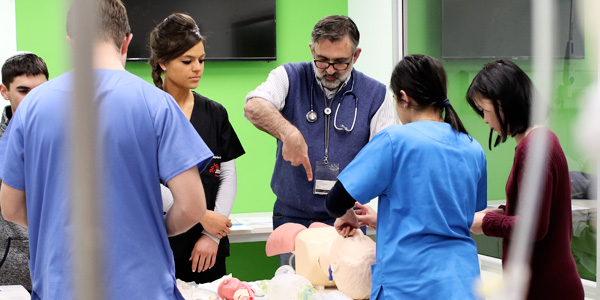Practicing medicine
- Wits University
A patient has just come in. His name’s Alan. His sister said he’s an asthmatic and when he woke up, his chest was really tight and he couldn't breathe.
His oxygen saturations are dropping. He needs medical attention. Please can you assist?
Wits students in the Health Sciences can now practice lifesaving techniques and other medical procedures in the new simulation laboratory. ‘Alan’ is SimMan3G, a high fidelity simulator.
Several simulated medical emergencies were set up for the Wits Students Physicians’ Society in July 2017. This society exposes medical students to specialist fields within internal medicine.
“The undergraduate Physicians Society had heard of our new sim lab and contacted me to assist them in developing a complex patient scenario that will promote their society and benefit their learning,” says Dr Hilary Thurling, simulation laboratory coordinator in the Centre for Health Sciences Education (CHSE) at Wits.
Thurling told students: “This is your start on your road to developing clinical judgment in medicine. It really is a learning experience. He [SimMan3G] will respond. He will not die. You’ve got to talk to him and treat him like he’s an actual human being.”
Students were exposed to four simulation stations including phlebotomy [an IV station to demonstrate drawing blood], airway intubation, oxygenation task training, and the high fidelity simulation asthma scenario with Alan the Asthmatic.
“The important thing is that he [Alan] can’t respond unless you actually implement a treatment. He can only improve on a drug if you verbalise that you’re giving it. Equally, he’s only going to give a blood pressure reading if you start the blood pressure machine,” said Dr Stuart Pattinson, associate lecturer in the Unit for Undergraduate Medical Education in the School of Clinical Medicine, who ‘operated’ Alan.
Thurling emphasises the importance of debriefing after a simulation. Debriefing is one of four best practices she describes in her PhD, awarded in July 2017, entitled: The Design and Development of a Programme for Simulation Best Practice in South African Nursing Education Institutions.
Other best practices include identifying learner objectives, integration of simulation into the curriculum, and the inclusion of deliberate practice.
Initially, students exposed to high fidelity simulation describe the medical experience as “overwhelming” – which is often how they experience their first actual patient interaction. Simulation is designed to be less traumatic than first clinical placements, as it provides a safe space for students to “practice” their skills, where a patient is not harmed.
The Physicians’ Society students confirmed in the post-simulation debriefing that they had learnt skills they could now more confidently apply in a clinical situation.
Thurling, who participated in the National League of Nurses Simulation Leaders Programme in 2015, has driven the introduction of simulation in the undergraduate nursing curriculum at Wits. Furthermore, she is introducing simulation to the undergraduate and postgraduate medical curricula, through training and raising awareness of simulation-based learning.
Her research found that, despite simulation being part of health care education for the last 40 years, there is resistance to embedding the education methodology in nursing and medical curricula. In South Africa presently, simulation is only being used in pockets at universities and nursing colleges, with no formal contextually relevant training programme in place - despite evidence that simulation improves students' outcomes and critical thinking.
Dr Dragan Mandić, senior clinical tutor in the Unit for Undergraduate Medical Education, ran the airway intubation station. He says his unit is struggling with the number of students. Simulation presents a possible solution.

“The first time they get to Airways is the fifth or sixth year when we actually allow them to touch a patient [so] we’re trying something new here,” he says.
The sim lab is available to disciplines across the Faculty of Health Sciences and to students. “My thesis was nursing orientated but can be translated into all medical faculties,” says Thurling, who encourages use of the sim lab.
